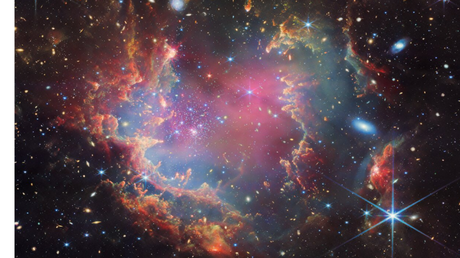
At this point, astronomers are used to the James Webb Space Telescope pushing the boundaries of astronomy - so it's no surprise that the $10 billion telescope has outdone itself again.
The James Webb Space Telescope (JWST) - with a little help from the Hubble Space Telescope - may have found a family of so-called "failed star" brown dwarfs in the Milky Way's satellite galaxy, the Small Magellanic Cloud (SMC). If so, it will be the first time astronomers have seen such bodies beyond the boundaries of our own galaxy.
The potential brown dwarfs are located on the edge of the SMC, a dwarf galaxy close to the Milky Way, in a young star cluster called NGC 602. NGC 602 is located about 200,000 light-years from Earth. This star cluster is well studied by astronomers because the thick clouds of dust and gas, the building blocks of stellar bodies, are believed to be places where intense star formation takes place. Star formation in this region of the SMC is further evidenced by an associated patch of ionized hydrogen, called N90. Atomic hydrogen is created when intense ultraviolet light from young stars takes electrons away from hydrogen atoms.
Because there is a shortage of elements heavier than hydrogen and helium (astronomers call these heavier elements "metals"), regions like NGC 602 and the broader SMC are good indicators of "metal-poor" galaxies found in the early universe. .
"By studying the young metal-poor brown dwarfs recently discovered in NGC602, we come closer to unraveling the secrets of how stars and planets formed under the harsh conditions of the early Universe," said team member and scientist from the University of Arizona, Elena Sabbi. a statement.
The same thick bands of gas and dust make these types of areas fascinating to study. However, those same lanes pose a challenge to astronomers because they absorb visible light.
Long-wavelength, low-frequency infrared light can slip through these clouds without being absorbed, and that is the wavelength of light in which the JWST studies the cosmos. This makes the JWST's Near-Infrared Camera (NIRCam) and Mid-Infrared Instrument (MIRI) ideal for studying the SMC and NGC 602. It is no wonder that the powerful space telescope has once again broken new ground with the possible first detection of extragalactic brown dwarfs.
Brown dwarfs fail...
Brown dwarfs get their somewhat unfair nickname from failed stars, because they form as stars from a collapsing cloud of too-dense gas and dust, but only reach a mass between 13 and 75 times that of Jupiter (0.13 to 0.75 times the mass of the sun). This means they cannot generate enough pressure and heat to trigger the fusion of hydrogen into helium in their cores, the process that defines a main sequence star.
Brown dwarfs differ from planets not only in terms of how they form. Unlike most planets, these objects also wander the cosmos, separate from their parent stars. She Doing share some characteristics with gas giant planets, such as the composition of their atmospheres and the storms that pass over them.
So far, astronomers have detected about 3,000 brown dwarfs, but all were within the boundaries of the Milky Way. These extragalactic brown dwarfs appear to confirm theories about how nascent stars fail.
"Our results fit very well with the theory that the mass distribution of bodies below the hydrogen burning limit is simply a continuation of the stellar distribution," team member ESA scientist Peter Zeidler said in the same statement. 'It seems they form the same way; they just don't accumulate enough mass to become a full-fledged star.'
...But the JWST succeeds
In addition to presenting groundbreaking science, the JWST/NIRCam/MIRI data collected as part of the JWST GO program number 2662 has also given us a stunningly beautiful image of NGC 602.
"This discovery highlights the power of using both Hubble and the JWST to study young stellar clusters," team member Antonella Nota, executive director of the International Space Science Institute in Switzerland and former JWST project scientist for the ESA, said in the statement . 'Hubble showed that NGC602 hosts very young, low-mass stars, but only with the JWST can we finally see the extent and significance of substellar mass formation in this cluster.
"Hubble and the JWST are an incredibly powerful telescope duo!"
Related stories:
- How the Rubin Observatory could detect thousands of 'failed stars'
- Hubble Space Telescope finds that 'failed stars' are also bad at relationships
- Earth-sized planet discovered around a cool red dwarf star shares its name with a cookie
The images of NGC 602, captured in April 2023, show the star clusters present and surrounding dust lanes and gas clouds. They herald a new era of detailed study of local metal-poor galaxies, which is not possible for the earliest hydrogen- and helium-dominated galaxies in the universe billions of light-years away.
"Only with the incredible sensitivity and spatial resolution in the right wavelength regime is it possible to detect these objects at such great distances," Zeidler concluded. "This has never been possible before and will remain impossible from the ground for the foreseeable future."
The team's research will be published on October 23 in The Astrophysical Journal.
